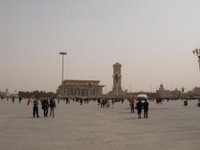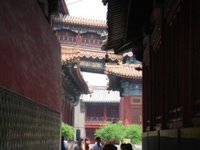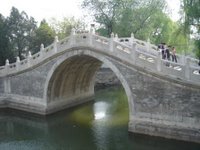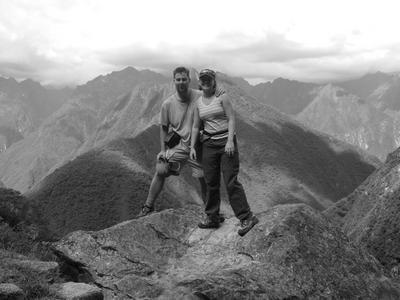Beijing (China)
 Our last train ride in China was a speedy 12 hour train from Xi'an to Beijing. We travelled in comfort on one of the nicest trains in China, although we did have to share a cabin with two strangers. Luckily for us, they didn't snore. Bad luck for them that Wade does. If you think the line ups are bad at airports, check out this picture of the Beijing Train Station and you won't feel so bad.
Our last train ride in China was a speedy 12 hour train from Xi'an to Beijing. We travelled in comfort on one of the nicest trains in China, although we did have to share a cabin with two strangers. Luckily for us, they didn't snore. Bad luck for them that Wade does. If you think the line ups are bad at airports, check out this picture of the Beijing Train Station and you won't feel so bad. This is going to be a very long post given that we spent 10 days in Beijing. 10 days was allotted partially because there are so many sites of interest and partially because we needed some downtime to plan the remainder of our travels.
Beijing was remarkably like Saskatchewan temperature wise. Cool spring days of about 16 to 20 degrees celsius, dry weather and VERY windy. Only difference is that instead of country soil whipping around in the city, in Beijing it is sand from the Gobi desert. The Gobi desert is slowly advancing towards Beijing every year and creates enormous sand storms in the city during the springtime.
Unlike Saskatchewan, Beijing must be one of the most confusing cities on earth. The city planners here must have loads of fun thinking about how they can utterly confuse the tourists. Street names change every few blocks, or so it seems, and the maps do not list all of the names. On top of that the maps do not list a lot of the side streets, etc. which makes it very difficult to find the shop or the restaurant that you may be looking for. Our absolute favourite experience however, was wondering around for close to two hours trying to find the subway stop around our hotel. We never did find it, only to discover later that the subway line had not been built yet. It would have been nice if the map had indicated it was a proposed line! Guess they are looking to save on printing costs.
Also fun is the fact that most cab drivers do not seem to know their own city map and if they don't speak English and you don't speak Chinese to give them directions...you get kicked out of their cab! Should be interesting to see how this city deals with the tons of tourists that are going to be here for the 2008 Beijing Olympics. That being said, the city is on a massive plan to make the city tourist friendly for 2008. Police officers are taking mandatory English lessons and cab drivers are also being encouraged to learn English. Lucky for us, most people in the city were very friendly. Lots of the children speak English and will often come up to you on the street and ask you if you need help when they see you pondering over a map.
 Although Beijing is a very historic city, it is also very modern. Here is a picture of some of the buildings close to Tiananmen Square. Massive, new buildings can be found all over Beijing. Construction can also be found all over Beijing in preparation for the Olympics. This unfortunately meant for us that some of the sites were not open for touring.
Although Beijing is a very historic city, it is also very modern. Here is a picture of some of the buildings close to Tiananmen Square. Massive, new buildings can be found all over Beijing. Construction can also be found all over Beijing in preparation for the Olympics. This unfortunately meant for us that some of the sites were not open for touring. If you got through the long dialogue above, you will appreciate the next comment. Here is a picture of Tiananmen Square, although only a small portion of it, given that it is the world's largest public square. This fact makes the next part slightly embarrassing in that Wade and I wandered around the perimeter of the square for a couple of hours not actually being able to locate it! One would think it should be fairly easy to spot. I tell you it's those damn maps!!! After a couple of confusing days...we have thoroughly oriented ourselves with the city.
If you got through the long dialogue above, you will appreciate the next comment. Here is a picture of Tiananmen Square, although only a small portion of it, given that it is the world's largest public square. This fact makes the next part slightly embarrassing in that Wade and I wandered around the perimeter of the square for a couple of hours not actually being able to locate it! One would think it should be fairly easy to spot. I tell you it's those damn maps!!! After a couple of confusing days...we have thoroughly oriented ourselves with the city.  One of the biggest tourist attractions is the Forbidden City or sometimes referred to as the Purple Forbidden City. At 720,000 m2 it is the world's largest palace complex and remarkably in the best condition. Chinese astrologists believe that God lives in the Purple Palace in the center of the universe and as the Emperor is the son of God, he must rightfully live in the Purple City. As the Emperor's abode was not open to the public, it earned the title as being forbidden.
One of the biggest tourist attractions is the Forbidden City or sometimes referred to as the Purple Forbidden City. At 720,000 m2 it is the world's largest palace complex and remarkably in the best condition. Chinese astrologists believe that God lives in the Purple Palace in the center of the universe and as the Emperor is the son of God, he must rightfully live in the Purple City. As the Emperor's abode was not open to the public, it earned the title as being forbidden.  There are 8,700 rooms in the palace and the city is divided into an inner and outer court. The inner court is where the Emperor lived with his wives, yes wives. Concubines were housed elsewhere. If you can see the doors in the picture you may notice that they have 9 rows of 9 bulbular nails in them. Odd numbers are considered holy and 9 being the highest single digit odd number is of course the most revered. Many Chinese tourists passing through the doorway will stop and touch some of the nails for good fortune.
There are 8,700 rooms in the palace and the city is divided into an inner and outer court. The inner court is where the Emperor lived with his wives, yes wives. Concubines were housed elsewhere. If you can see the doors in the picture you may notice that they have 9 rows of 9 bulbular nails in them. Odd numbers are considered holy and 9 being the highest single digit odd number is of course the most revered. Many Chinese tourists passing through the doorway will stop and touch some of the nails for good fortune.  24 different Emperors lived in this City, prior to the last Emperor being banished from the palace in 1924 due to the Feng Yuxiang coup. From all accounts, the Forbidden City was a harsh place to live for all of those apart from the Emperor. Wives and concubines were buried alive when the Emperor they served died. Enuchs and maid servants were slaves, working day and night. They were bound by countless strange rules, harshly enforced, such as the manner in which they slept. Sleeping on your back was meant to offend the gods. Even the Imperial Doctor had much to fear. If his treatments caused distress to the Emperor by worsening his conditions, he was killed.
24 different Emperors lived in this City, prior to the last Emperor being banished from the palace in 1924 due to the Feng Yuxiang coup. From all accounts, the Forbidden City was a harsh place to live for all of those apart from the Emperor. Wives and concubines were buried alive when the Emperor they served died. Enuchs and maid servants were slaves, working day and night. They were bound by countless strange rules, harshly enforced, such as the manner in which they slept. Sleeping on your back was meant to offend the gods. Even the Imperial Doctor had much to fear. If his treatments caused distress to the Emperor by worsening his conditions, he was killed. The Purple Forbidden City is by no means purple. All of the roofs have yellow glazed ceramic tiles and red wooden structures beneath. Only the Emperor could use the colour yellow and anybody else found using it would be charged with treason. Yellow is important because of the theory of Ying Yang & the 5 Elements, which states that gold, wood, water, fire & soil symbolize 5 directions. Soil is located in the center and represents yellow. As the Emperor's palace is located in the center of the Chinese world, yellow becomes sacred. Here is a picture taken in the Imperial Garden in the inner court. Even a brutal Emperor needs a place of tranquility.
The Purple Forbidden City is by no means purple. All of the roofs have yellow glazed ceramic tiles and red wooden structures beneath. Only the Emperor could use the colour yellow and anybody else found using it would be charged with treason. Yellow is important because of the theory of Ying Yang & the 5 Elements, which states that gold, wood, water, fire & soil symbolize 5 directions. Soil is located in the center and represents yellow. As the Emperor's palace is located in the center of the Chinese world, yellow becomes sacred. Here is a picture taken in the Imperial Garden in the inner court. Even a brutal Emperor needs a place of tranquility. Here is a picture of the Hall of Prayer for Good Harvests in the Temple of Heaven Park (a 267 hectare park). The Park was originally a place for the Emperor to come and pray for good harvests and for the forgiveness of sins. This structure is unique in that no nails or cement are used. It also is constructed around the symbolic 9 number. 3 marble terraces, 3 stone steps and a 3 tiered roof, representing mortals, the earth and heaven.
Here is a picture of the Hall of Prayer for Good Harvests in the Temple of Heaven Park (a 267 hectare park). The Park was originally a place for the Emperor to come and pray for good harvests and for the forgiveness of sins. This structure is unique in that no nails or cement are used. It also is constructed around the symbolic 9 number. 3 marble terraces, 3 stone steps and a 3 tiered roof, representing mortals, the earth and heaven. A picture of Wade, visibly stressed in one of the many tea shops in Beijing. Who knew there were so many kinds and qualities of tea. We heard stories from other unsuspecting tourists who were invited to elaborate tea ceremonies and presented with a US $200 bill upon departure. We decided to skip the ceremony and just go to a shop. Even so we were subject to high pressure sales tactics.
A picture of Wade, visibly stressed in one of the many tea shops in Beijing. Who knew there were so many kinds and qualities of tea. We heard stories from other unsuspecting tourists who were invited to elaborate tea ceremonies and presented with a US $200 bill upon departure. We decided to skip the ceremony and just go to a shop. Even so we were subject to high pressure sales tactics. Here is a picture taken in one of the corridors of the Lama temple, the most renowned Tibetan Buddhist temple outside of Tibet. It was one of the nicest temples we have been to so far in that it was mesmerizing with all its bright colours, active worshippers burning incense and bowing to the many buddhas and monks wandering in and amongst the buildings attending to daily duties. No body seemed too concerned about the nosy tourists wildly snapping pictures. I was enthralled by the chanting of the monks in the background and brought back to reality when I realized it was a CD playing from the nearby gift store. I guess even practicing temples have a commercial side. I now understand why Jesus was so upset by those profiting off what should be a spiritual place.
Here is a picture taken in one of the corridors of the Lama temple, the most renowned Tibetan Buddhist temple outside of Tibet. It was one of the nicest temples we have been to so far in that it was mesmerizing with all its bright colours, active worshippers burning incense and bowing to the many buddhas and monks wandering in and amongst the buildings attending to daily duties. No body seemed too concerned about the nosy tourists wildly snapping pictures. I was enthralled by the chanting of the monks in the background and brought back to reality when I realized it was a CD playing from the nearby gift store. I guess even practicing temples have a commercial side. I now understand why Jesus was so upset by those profiting off what should be a spiritual place. One afternoon we made our way out to the summer abode of the Emperor, the Summer Palace, which is located 12 kms outside of Beijing. It is 726 acres, of which 3/4's of it is water. The Palace is built around Lake Kunming. It is funny to think that the Emperor only went 12 kms outside of the city to escape the heat of the Forbidden City. Strange enough, it was much cooler. There are 3,000 structures of pavilions, towers and bridges built in an amongst the hills and gardens around the lake. We walked for a few hours on the trails around the East Gate.
One afternoon we made our way out to the summer abode of the Emperor, the Summer Palace, which is located 12 kms outside of Beijing. It is 726 acres, of which 3/4's of it is water. The Palace is built around Lake Kunming. It is funny to think that the Emperor only went 12 kms outside of the city to escape the heat of the Forbidden City. Strange enough, it was much cooler. There are 3,000 structures of pavilions, towers and bridges built in an amongst the hills and gardens around the lake. We walked for a few hours on the trails around the East Gate.  A less well known area of Beijing is the Underground City. It was literally a cool experience in that 200 kms of tunnels exist at between 8 and 18 meters beneath the ground surface. Why you ask? Well, because it turns out the Chinese were terrified of the Russians invading or bombing them. I guess their Communist bond was not as tight as appeared from the surface. Or at least not tight enough that the Chinese truly trusted the Russians. All of the tunnels were hand dug over a period of 10 years and contained over 1,000 anti raid chambers. The Underground City was never used, making it a great "make work" project, but was planned to house up to 300,000 people. How they were going to decide who could take shelter and who would have to take refuge in the hills, I do not know. However, I imagine it couldn't hurt to be considered key personnel.
A less well known area of Beijing is the Underground City. It was literally a cool experience in that 200 kms of tunnels exist at between 8 and 18 meters beneath the ground surface. Why you ask? Well, because it turns out the Chinese were terrified of the Russians invading or bombing them. I guess their Communist bond was not as tight as appeared from the surface. Or at least not tight enough that the Chinese truly trusted the Russians. All of the tunnels were hand dug over a period of 10 years and contained over 1,000 anti raid chambers. The Underground City was never used, making it a great "make work" project, but was planned to house up to 300,000 people. How they were going to decide who could take shelter and who would have to take refuge in the hills, I do not know. However, I imagine it couldn't hurt to be considered key personnel.  And lastly, a trip to Beijing would not be complete without experiencing some Peking duck. We put our fears of Bird Flu aside and delved into the local cuisine. Tanis, you would have gone quackers for this place. Wade and I ate an entire duck in Chinese pancakes at the restaurant Quanjude Roast Duck Restaurant. One could say we were in good company in that George Bush has eaten at this restaurant, but not so sure of that. We really did waddle out of here. Ducky on the other hand did not.
And lastly, a trip to Beijing would not be complete without experiencing some Peking duck. We put our fears of Bird Flu aside and delved into the local cuisine. Tanis, you would have gone quackers for this place. Wade and I ate an entire duck in Chinese pancakes at the restaurant Quanjude Roast Duck Restaurant. One could say we were in good company in that George Bush has eaten at this restaurant, but not so sure of that. We really did waddle out of here. Ducky on the other hand did not.


0 Comments:
Post a Comment
<< Home